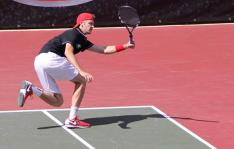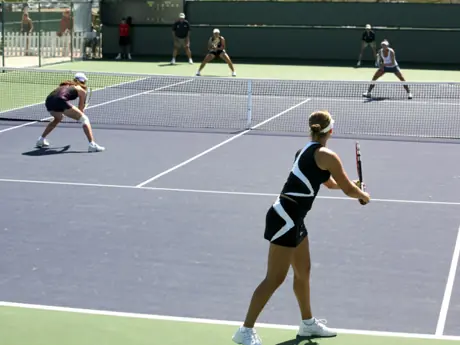Playing against hard hitters in tennis can be intimidating. There will always be players who hit bigger than you and are more consistent. However, there are players at all levels who take a lot of big swings, but are not always pinpoint accurate, and can only hit one or two balls in the court in a row.
When battling a big hitter there are things you can do to throw your opponent off of their groove to try to neutralize their power. There are also ways to prepare to return the hard strokes if you're not comfortable doing so.
Don't Get Into a Power Struggle
1 of 9
There's no need to match a big hitter's power with your own. Most big hitters like it when their opponent hits the ball hard, because it helps them generate power as well. If you try to match power for power and that is not your normal game plan, you'll fall right into the hands of your opponent.
Take some pace off of the ball and use placement. Force your opponent to generate all the pace off of their shots. This can help you draw more errors out of your opponent if you can place the ball well.
Find:
Your Next Tennis EventAvoid the Strike Zone
2 of 9
One of the best tactics you can use against power hitters is to keep them from hitting the ball in their strike zone. The strike zone is where your opponent would naturally swing the racquet and come into contact with the ball.
Never hit the ball with little spin so it lands a couple of feet behind the service line. If your opponent is able to step in to hit his or her shots, they will be in their comfort zone.
Find:
Your Next Tennis EventSpin is King
3 of 9
Using spin is a big help against power players. Try slicing the ball to keep it low. This forces your opponent to have to hit upward on the ball, and makes it tougher to take a big swing. Lots of topspin also makes it tough for your opponent to take big swings at the ball if you hit it deep enough in the court.
Find:
Your Next Tennis EventPlacement is Power
4 of 9
Placement is also key. If you can keep your opponent deep in the court it will be harder for them to generate power and will give you more time to react to their shots. Hitting short angled slices will also force them to move forward and have to hit upward.
Keeping your opponent moving side-to-side is usually a good play, so that they have less time to prepare and fewer opportunities to step into the ball to take a big swing. That covers what you can do to try to neutralize your opponent's power. However, they will still hit plenty of hard shots, and you need to be prepared to return them.
Find:
Your Next Tennis EventReturn of Serve Strategy
5 of 9
The serve is one shot that you cannot control; all you can do is to react to the ball. The problem with big serves is that you don't have enough time to take your normal swing to return the ball.
If that is the case with your return of serve, try blocking the serve back. Keep the ball deep when you block it back. What you have to watch out for with this method is not to get lazy and just block the ball down the middle of the court every time. A good player will recognize this, and sneak into the net after the serve and put away an easy volley off of your weak return.
Try to block the ball with a purpose if you can. If you can block the ball to their backhand or down the line, it's probably a safer play than just blocking it back down the middle. If you want to swing at the return, make sure you take small backswings to give you enough time to swing at the ball. By the time you take a large backswing, the ball could already be past you for an ace.
Find:
Your Next Tennis EventBring the Racket Back Early
6 of 9
Bring the racket back sooner than you normally would to hit the ball against hard hitters. This helps to reduce the feeling of being rushed to hit your shots. If you bring your racket back sooner than normal, you'll feel like you have more time to react to the ball. As soon as you see which side the ball is coming toward, get your racket back to that side immediately.
Find:
Your Next Tennis EventMake Your Opponent Take Another Shot
7 of 9
If you have to block back some of your groundstrokes, go for it. Sometimes your opponent can hit the ball so hard, it's all you can do. The best strategy is to get the ball back over the net and force them to hit another shot.
Just because your opponent hit two big shots in a row does not mean they can hit three. A lot of big hitters get impatient and go for too much too early or aren't consistent and will miss after one or two shots. Put the ball back in the court and see what happens. Don't be afraid to lob if you have to. If your opponent hits the ball too hard for you to handle, throw up a deep lob to stay in the point.
Find:
Your Next Tennis EventPatience, Patience, Patience
8 of 9
Be patient, and work the point to your advantage. Take the big power hitters out of their power zone with spin, placement and, most importantly, patience. Make sure you do whatever you have to do to hit the ball back over the net. It's tempting to try to match the power of your opponent, but sometimes that's the worst thing you can do, especially if it is not your typical game plan.






Discuss This Article